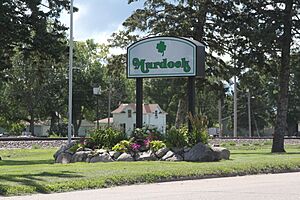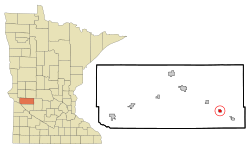Murdock, Minnesota facts for kids
Quick facts for kids
Murdock
|
|
|---|---|
 |
|

Location of Murdock, Minnesota
|
|
| Country | United States |
| State | Minnesota |
| County | Swift |
| Area | |
| • Total | 0.62 sq mi (1.61 km2) |
| • Land | 0.62 sq mi (1.61 km2) |
| • Water | 0.00 sq mi (0.00 km2) |
| Elevation | 1,086 ft (331 m) |
| Population
(2020)
|
|
| • Total | 306 |
| • Density | 491.96/sq mi (189.90/km2) |
| Time zone | UTC-6 (Central (CST)) |
| • Summer (DST) | UTC-5 (CDT) |
| ZIP code |
56271
|
| Area code(s) | 320 |
| FIPS code | 27-44818 |
| GNIS feature ID | 2395140 |
Murdock is a small town located in Swift County, Minnesota, in the United States. In 2020, about 306 people lived there.
Murdock is part of the Kerkhoven-Murdock-Sunburg (KMS) school district. Young students in grades PreK-5 attend the Kerkhoven-Murdock-Sunburg Elementary School right in Murdock.
Contents
History of Murdock
A post office opened in Murdock in 1878. The town was officially planned out in 1881 by a person named S. S. Murdock. The town was named after him. Murdock became an official city in the same year, 1881.
Recent Events in Murdock
In June 2020, a group called the Asatru Folk Assembly (AFA) bought an old Lutheran church building in Murdock. The AFA is a neo-pagan religion. They wanted to use the church as a meeting place for their members in the Northern Great Plains area.
On December 9, 2020, the Murdock City Council voted to let the AFA use the building. This decision caused a lot of discussion and concern. The AFA has a membership policy that led to accusations of discrimination. Many people in Minnesota, over 120,000, signed a petition asking the city to stop the AFA from using the former church.
Geography of Murdock
Murdock is a small city. According to the United States Census Bureau, the city covers about 0.56 square miles (1.61 square kilometers). All of this area is land.
U.S. Route 12 is an important road that runs through the community.
Population Information
The population of Murdock has changed over the years. Here is a look at how many people have lived in Murdock during different census years:
| Historical population | |||
|---|---|---|---|
| Census | Pop. | %± | |
| 1890 | 130 | — | |
| 1900 | 275 | 111.5% | |
| 1910 | 288 | 4.7% | |
| 1920 | 391 | 35.8% | |
| 1930 | 326 | −16.6% | |
| 1940 | 334 | 2.5% | |
| 1950 | 393 | 17.7% | |
| 1960 | 381 | −3.1% | |
| 1970 | 358 | −6.0% | |
| 1980 | 343 | −4.2% | |
| 1990 | 282 | −17.8% | |
| 2000 | 303 | 7.4% | |
| 2010 | 278 | −8.3% | |
| 2020 | 306 | 10.1% | |
| U.S. Decennial Census | |||
Murdock's Population in 2010
In 2010, there were 278 people living in Murdock. These people lived in 117 different homes, and 74 of these were families. The city had about 496 people per square mile.
Most of the people in Murdock were White (95%). A small number of people were from other racial backgrounds (4%) or from two or more races (1.1%). About 7.2% of the population identified as Hispanic or Latino.
Many homes (32.5%) had children under 18 living there. Almost half of the homes (47.9%) were married couples living together. Some homes were led by a single mother (9.4%) or a single father (6.0%). About one-third of all homes were individuals living alone.
The average age of people in Murdock was 37.4 years old. About 27% of the residents were under 18. Around 10.4% of the people were 65 years old or older. The population was almost evenly split between males (48.2%) and females (51.8%).
Famous People from Murdock
Some notable people have connections to Murdock:
- Andrew Falk - a farmer and state legislator.
- David Frederickson - served as the Commissioner of the Minnesota Department of Agriculture.
- Howard Wads Rundquist - a businessman, teacher, and state legislator.
Images for kids
-
The Sabin S. Murdock House, which is listed on the National Register of Historic Places.
See also
 In Spanish: Murdock (Minnesota) para niños
In Spanish: Murdock (Minnesota) para niños






